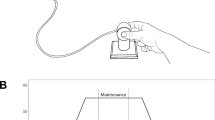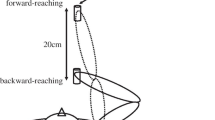Abstract
We investigated age related changes in the control of precision grip in 29 healthy adults spanning early adulthood to middle age (21–67 years). Subjects performed a visually guided, isometric precision grip ramp-and-hold force-tracking task. Target force levels were 3, 6, and 9 N. Precision and performance of force regulation was quantified. Larger errors were made during the ramp than during the hold phase. Age correlated positively with the amount of error at the lowest (3 N) force level in both phases. Force onsets were systematically earlier in middle-aged subjects and the average slope of the force during the ramp decreased with increasing age. The results show that precision during low grip force control decreases already during middle age and those subjects may modify their force generation strategies to compensate for early and subtle degenerative changes in the motor system before decline in grip strength is apparent.







Similar content being viewed by others
References
Augurelle AS, Smith AM, Lejeune T et al (2003) Importance of cutaneous feedback in maintaining a secure grip during manipulation of hand-held objects. J Neurophysiol 89(2):665–671
Bleuse S, Cassim F, Blatt JL et al (2006) Effect of age on anticipatory postural adjustments in unilateral arm movement. Gait Posture 24(2):203–210
Brown WF (1973) Functional compensation of human motor units in health and disease. J Neurol Sci 20(2):199–209
Campbell MJ, McComas AJ, Petito F (1973) Physiological changes in ageing muscles. J Neurol Neurosurg Psychiatry 36(2):174–182
Christou EA, Carlton LG (2001) Old adults exhibit greater motor output variability than young adults only during rapid discrete isometric contractions. J Gerontol A Biol Sci Med Sci 56(12):524–532
Christou EA, Tracy BL (2006) Aging and variability in motor output. In: Davids K, Bennett S, Newell KM (eds) Movement system variability, pp 199–215
Christou EA, Jakobi JM, Critchlow A et al (2004) The 1- to 2-Hz oscillations in muscle force are exacerbated by stress, especially in older adults. J Appl Physiol 97(1):225–235
Cole KJ (1991) Grasp force control in older adults. J Mot Behav 23(4):251–258
Cole KJ, Rotella DL, Harper JG (1999) Mechanisms for age-related changes of fingertip forces during precision gripping and lifting in adults. J Neurosci 19(8):3238–3247
Cruz-Sánchez FF, Moral A, Tolosa E et al (1998) Evaluation of neuronal loss, astrocytosis and abnormalities of cytoskeletal components of large motor neurons in the human anterior horn in aging. J Neural Transm 105(6–7):689–701
Danion F, Descoins M, Bootsma RJ (2007) Aging affects the predictive control of grip force during object manipulation. Exp Brain Res 180(1):123–137
Doherty TJ (2003) Invited review: aging and sarcopenia. J Appl Physiol 95(4):1717–1727
Doherty TJ, Brown WF (1997) Age-related changes in the twitch contractile properties of human thenar motor units. J Appl Physiol 82(1):93–101
Enoka RM, Christou EA, Hunter SK et al (2003) Mechanisms that contribute to differences in motor performance between young and old adults. J Electromyogr Kinesiol 13(1):1–12
Erim Z, Beg MF, Burke DT et al (1999) Effects of aging on motor unit control properties. J Neurophysiol 82(5):2081–2091
Galea V (1996) Changes in motor unit estimates with aging. J Clin Neurophysiol 13(3):253–260
Galganski ME, Fuglevand AJ, Enoka RM (1993) Reduced control of motor output in a human hand muscle of elderly subjects during submaximal contractions. J Neurophysiol 69(6):2108–2115
Gilles MA, Wing AM (2003) Age-related changes in grip force and dynamics of hand movement. J Mot Behav 35(1):79–85
Goggin NL, Meeuwsen HJ (1992) Age-related differences in the control of spatial aiming movements. Res Q Exerc Sport 63(4):366–372
Hausdorff JM, Yogev G, Springer S et al (2005) Walking is more like catching than tapping: gait in the elderly as a complex cognitive task. Exp Brain Res 164(4):541–548
Hermsdörfer J, Hagl E, Nowak DA (2004) Deficits of anticipatory grip force control after damage to peripheral and central sensorimotor systems. Hum Mov Sci 23(5):643–662
Heuninckx S, Wenderoth N, Debaere F et al (2005) Neural basis of aging: the penetration of cognition into action control. J Neurosci 25(29):6787–6796
Jagacinski RJ, Liao MJ, Fayyad EA (1995) Generalized slowing in sinusoidal tracking by older adults. Psychol Aging 10(1):8–19
Johansson RS, Westling G (1987) Signals in tactile afferents from the fingers eliciting adaptive motor responses during precision grip. Exp Brain Res 66(1):141–154
Jonsson E, Henriksson M, Hirschfeld H (2007) Age-related differences in postural adjustments in connection with different tasks involving weight transfer while standing. Gait Posture 26(4):508–515
Kamen G, Knight CA (2004) Training-related adaptations in motor unit discharge rate in young and older adults. J Gerontol A Biol Sci Med Sci 59(12):1334–1338
Kaneko A, Asai N, Kanda T (2005) The influence of age on pressure perception of static and moving two-point discrimination in normal subjects. J Hand Ther 18(4):421–424
Knight CA, Kamen G (2007) Modulation of motor unit firing rates during a complex sinusoidal force task in young and older adults. J Appl Physiol 102(1):122–129
Kornatz KW, Christou EA, Enoka RM (2005) Practice reduces motor unit discharge variability in a hand muscle and improves manual dexterity in old adults. J Appl Physiol 98(6):2072–2080
Kurillo G, Zupan A, Bajd T (2004) Force tracking system for the assessment of grip force control in patients with neuromuscular diseases. Clin Biomech 19(10):1014–1021
Laidlaw DH, Bilodeau M, Enoka RM (2000) Steadiness is reduced and motor unit discharge is more variable in old adults. Muscle Nerve 23(4):600–612
Lazarus JA, Haynes JM (2000) Isometric pinch force control and learning in older adults. Exp Aging Res 23(2):179–199
Lexell J, Taylor CC, Sjöström M (1988) What is the cause of the ageing atrophy? Total number, size and proportion of different fiber types studied in whole vastus lateralis muscle from 15- to 83-year-old men. J Neurol Sci 84(2–3):275–294
Lindenberger U, Markise M, Baltes PB (2000) Memorizing while walking: increase in dual-task costs from young adulthood to old age. Psychol Aging 15:417–436
Mattay VS, Fera F, Tessitore A et al (2002) Neurophysiological correlates of age-related changes in human motor function. Neurology 58(4):630–635
Oliviero A, Profice P, Tonali PA et al (2006) Effects of aging on motor cortex excitability. Neurosci Res 55(1):74–77
Pai YC, Rogers MW, Patton J et al (1998) Static versus dynamic predictions of protective stepping following waist-pull perturbations in young and older adults. J Biomech 31(12):1111–1118
Pieperhoff P, Hömke L, Schneider F et al (2008) Deformation field morphometry reveals age-related structural differences between the brains of adults up to 51 years. J Neurosci 28(4):828–842
Ranganathan VK, Siemionow V, Sahgal V et al (2001) Effects of aging on hand function. J Am Geriatr Soc 49(11):1478–1484
Shim JK, Lay BS, Zatsiorsky VM et al (2004) Age-related changes in finger coordination in static prehension tasks. J Appl Physiol 97(1):213–224
Smith CD, Umberger GH, Manning EL et al (1999) Critical decline in fine motor hand movements in human aging. Neurology 53(7):1458–1461
Sosnoff JJ, Newell KM (2006) Are age-related increases in force variability due to decrements in strength? Exp Brain Res 174(1):86–94
Tracy BL, Maluf KS, Stephenson JL et al (2005) Variability of motor unit discharge and force fluctuations across a range of muscle forces in older adults. Muscle Nerve 32(4):533–540
Vaillancourt DE, Newell KM (2003) Aging and the time and frequency structure of force output variability. J Appl Physiol 94(3):903–912
Vaillancourt DE, Larsson L, Newell KM (2003) Effects of aging on force variability, single motor unit discharge patterns, and the structure of 10, 20, and 40 Hz EMG activity. Neurobiol Aging 24(1):25–35
Voelcker-Rehage C, Alberts JL (2005) Age-related changes in grasping force modulation. Exp Brain Res 166(1):61–70
Voelcker-Rehage C, Stronge AJ, Alberts JL (2006) Age-related differences in working memory and force control under dual-task conditions. Neuropsychol Dev Cogn B Aging Neuropsychol Cogn 13(3–4):366–384
Voermans NC, Schelhaas HJ, Munneke M et al (2006) Dissociated small hand muscle atrophy in aging: the ‘senile hand’ is a split hand. Eur J Neurol 13(12):1381–1384
Warabi T, Noda H, Kato T (1986) Effect of aging on sensorimotor functions of eye and hand movements. Exp Neurol 92(3):686–697
Ward NS, Frackowiak RS (2003) Age-related changes in the neural correlates of motor performance. Brain 126:873–888
Woollacott MH, Manchester DL (1993) Anticipatory postural adjustments in older adults: are changes in response characteristics due to changes in strategy? J Gerontol 48(2):64–70
Acknowledgments
This study was in part supported by grants of the City of Paris (Accueil des Chercheurs Etrangers) and of Hjärnfonden (the Swedish Brain Foundation) to PL.
Author information
Authors and Affiliations
Corresponding author
Rights and permissions
About this article
Cite this article
Lindberg, P., Ody, C., Feydy, A. et al. Precision in isometric precision grip force is reduced in middle-aged adults. Exp Brain Res 193, 213–224 (2009). https://doi.org/10.1007/s00221-008-1613-4
Received:
Accepted:
Published:
Issue Date:
DOI: https://doi.org/10.1007/s00221-008-1613-4




